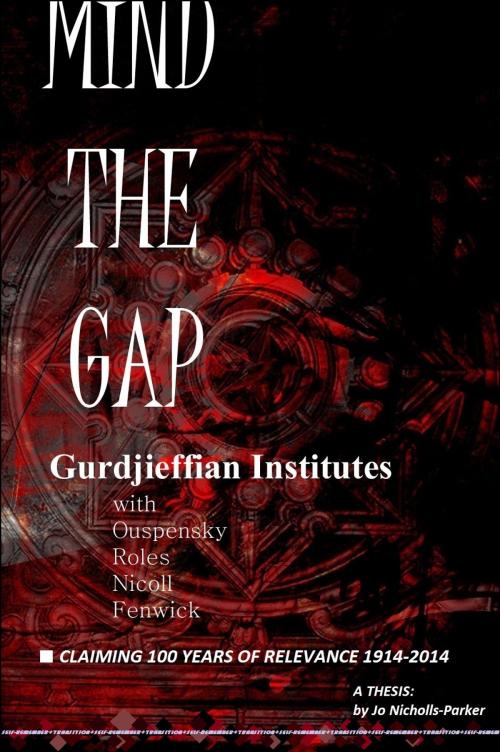MIND THE GAP: Gurdjieffian Institutes with Ouspensky, Roles, Nicoll, Fenwick
Nonfiction, Religion & Spirituality, Philosophy, Phenomenology, Social & Cultural Studies, Social Science, Methodology, Eastern Religions, General Eastern Religions| Author: | Jo Nicholls-Parker | ISBN: | 1230000262237 |
| Publisher: | Kobo Inc. | Publication: | August 22, 2014 |
| Imprint: | Language: | English |
| Author: | Jo Nicholls-Parker |
| ISBN: | 1230000262237 |
| Publisher: | Kobo Inc. |
| Publication: | August 22, 2014 |
| Imprint: | |
| Language: | English |
The subject of this thesis is the spiritual practices taught by Gurdjieff (1870-1949) and the legacy of these teachings in the major spiritual groups that have aspired to follow this path. I argue that at the core of these spiirtual techniques are the practices that Gurdjieff referred to as "self-remembering" and "transition" and that by an analysis of these it is possible to articulate Gurdjieff's spiritual system in a novel fashion. This articulation is then utilized to explore the different ways in which his system was developed by his disciples. The more recent studies of spirituality and spiritual techniques allow us to critically reconsider Gurdjieff and his legacy in a systemic and academic fashion. The thesis concludes that while Gurdjieff was a man and teacher of his time many of the themes of his teachings continue to resonate in contemporary spiritual movements and that his influence has been wider than is often acknowledged, and that at the centre of this legacy are his spiritual techniques. Gurdjieff used storytelling to advance an in-depth understanding of his teaching to his principal followers and it is through an evaluation of this investment that the promotion of self-awareness is seen as pivotal and central to any evaluation of the spiritual legacy. The way to distinguish Gurdjieff's teaching from other of his principal followers, now 100 years on, is evident when contemporary literature can provide a valuable and insightful means to differentiate influence. The key contribution offered in the name of contemplative neuroscience in this thesis reveals that Gurdjieff taught by employing a "narrative self-focus," while his principal followers taught by employing a "self-reverential" devotional focus. This sets the benchmark of the legacy up anew as reflecting at least two different theological approaches: 'self-focused' or 'self-reverential.' My critical analysis of Gurdjieff's techniques will differ from a number of academic appraisals in that essentially hagiography is offered as a replacement for biography, and in this way with the assistance of phenomenology the legacy can be explained in a more true and reasonable fashion. This is because the lesser weight on biography allows the phenomenological perspectives to assist the teachings arrival at the ethereal state crystallization, revealing Gurdjieff's personal agenda and indicating his means of delivery.
The subject of this thesis is the spiritual practices taught by Gurdjieff (1870-1949) and the legacy of these teachings in the major spiritual groups that have aspired to follow this path. I argue that at the core of these spiirtual techniques are the practices that Gurdjieff referred to as "self-remembering" and "transition" and that by an analysis of these it is possible to articulate Gurdjieff's spiritual system in a novel fashion. This articulation is then utilized to explore the different ways in which his system was developed by his disciples. The more recent studies of spirituality and spiritual techniques allow us to critically reconsider Gurdjieff and his legacy in a systemic and academic fashion. The thesis concludes that while Gurdjieff was a man and teacher of his time many of the themes of his teachings continue to resonate in contemporary spiritual movements and that his influence has been wider than is often acknowledged, and that at the centre of this legacy are his spiritual techniques. Gurdjieff used storytelling to advance an in-depth understanding of his teaching to his principal followers and it is through an evaluation of this investment that the promotion of self-awareness is seen as pivotal and central to any evaluation of the spiritual legacy. The way to distinguish Gurdjieff's teaching from other of his principal followers, now 100 years on, is evident when contemporary literature can provide a valuable and insightful means to differentiate influence. The key contribution offered in the name of contemplative neuroscience in this thesis reveals that Gurdjieff taught by employing a "narrative self-focus," while his principal followers taught by employing a "self-reverential" devotional focus. This sets the benchmark of the legacy up anew as reflecting at least two different theological approaches: 'self-focused' or 'self-reverential.' My critical analysis of Gurdjieff's techniques will differ from a number of academic appraisals in that essentially hagiography is offered as a replacement for biography, and in this way with the assistance of phenomenology the legacy can be explained in a more true and reasonable fashion. This is because the lesser weight on biography allows the phenomenological perspectives to assist the teachings arrival at the ethereal state crystallization, revealing Gurdjieff's personal agenda and indicating his means of delivery.















